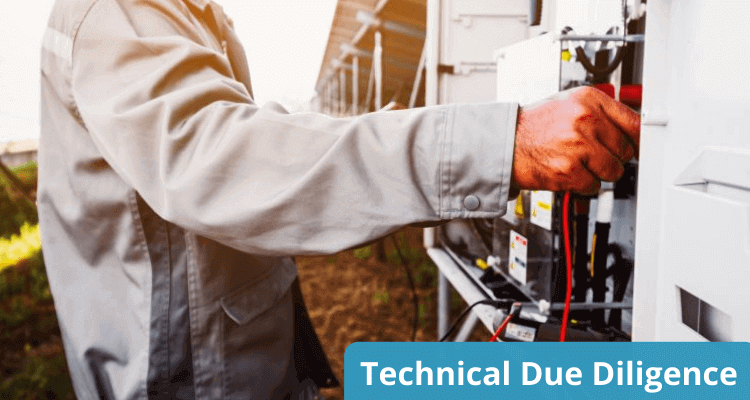Photovoltaic Technical Due Diligence
Ensure you won’t run into any technical or organisational pitfalls before buying a photovoltaic system. Find out which risks are examined and what significance they hold.
Before investing, you can carry out technical due diligence to make sure that the investment is a practical one and can generate the expected returns. You can hire experienced experts to carry this out. As a result, you’ll receive an independent assessment of any technical and organisational risks.
Before making any purchase, you should find out whether the yield forecast is realistic. For new systems, we advise combing through the project planning in detail, so that planning errors can be identified and eliminated before the system is built. It is equally important to recognise organisational snares.
One disastrous example might be a photovoltaic system unable to be connected for months or even years due to a lack of available transformers or a lapsed grid commitment. If the system has already been constructed, the documentation should be carefully reviewed. For systems already in operation, an on-site inspection is recommended.
When should the technology be inspected?
Technical due diligence is a practical measure starting from sizes of about 100 kWp installed capacity. New systems should be inspected as soon as the installation site and grid connection have been acquired.
Since neither the implementation nor the contract design of an existing system can be altered, ask to receive the inspection report before signing the contract. With the help of an independent risk assessment, you can find out whether the investment makes sense, or if it would be better to buy a different photovoltaic system.
What should be inspected?
In addition to technology, technical due diligence also examines organisational aspects:
Realistic yield forecast: It is essential to make a yield assessment independent of either the seller or system builder. The simulation takes into account planned or already constructed technology, orientation, module inclination, and any shade cast by trees, mountains, etc. Site-specific climate models are also used to produce a realistic yield forecast.
Plausible electricity marketing: A plausibility check for electricity marketing is also relevant in terms of yield. You should come to conclusive assumptions regarding the calculation of own consumption. Basic requirements for remuneration under the EEG must also be fulfilled.
Functioning solar technology: It must be determined whether the planned components of a new system truly are suitable and available for use. For existing systems, various randomly sampled measurements and an on-site inspection can confirm the technical conditions and functionality. Thermography can also be used to detect excessively heated areas, revealing potential defects.
Example: Plug connections One common objection during on-site technical inspections concerns the plug connections. But if care is taken during the planning stage to ensure that the plug connections are all of the correct type, matching connectors can be ordered and installed straight away. This eliminates the need for subsequent, expensive dismantling of individual modules.
Structural analysis and lightning protection: A structural analysis is required to operate roof systems. If the building already has lightning protection, it must be ensured that it is not impaired by the PV system.
Conditions: Any other requirements, such as lightning or fire protection, must exist and be technically fulfilled.
Grid connection: A fundamental organisational inspection should be carried out for new systems to determine whether a valid grid commitment exists for the photovoltaic system. The grid access point should also be located and the economic viability of the grid connection confirmed.
Land: Easements, i.e. corresponding rights of use, for the system site and cable routes must be entered into the land register and technical implementation made accordingly. Maintenance access for the PV system must also exist and its use must be contractually secured.
Project contracts: The plausibility of project contracts and the technical feasibility of any conditions must be inspected. It can then quickly determined from experience whether essential aspects are absent or are unusual for the market. For example, the acceptance procedure should have been defined so that what does and what does not constitute a defect can be clearly determined after the fact.
When reviewing organisational requirements, there may be overlaps with legal due diligence. Legal due diligence clarifies legal issues, while technical due diligence is focused on implementation.
Results of the technical inspection
You will receive an assessment of the technical risks: this will form a basis for your investment decision. The following common categorisation may come in use:
- Acceptable risks, that you can put up with.
- Manageable risks, that need to be actively addressed.
- Deal-breaker risks, that advise against purchase.
Summary
- The earlier technical due diligence is carried out, the more effectively potential project risks can be identified and remedied.
- Due diligence is advisable and economically practical from system capacity of 100 kWp and greater.
- Existing systems should always be inspected on site.
This article was written with the support of Dr Daniel Faltermeier, Managing Partner, helioconsult GmbH.
To read the original article in German, click here.
This article was published in our investment guide. For all other articles and information on Direct investment in commercial-sized photovoltaic systems, please visit: Milk the Sun – PV Investment Guide.





